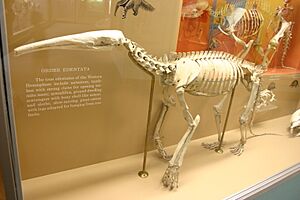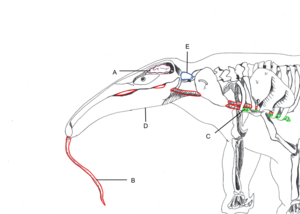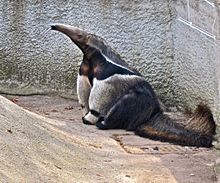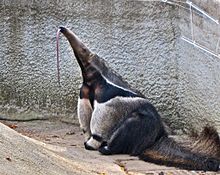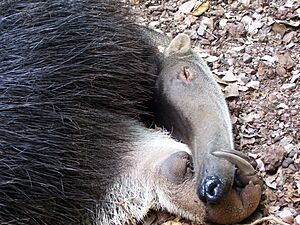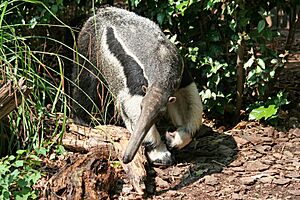Giant Anteater facts for kids
Quick facts for kids Giant anteater |
|
|---|---|
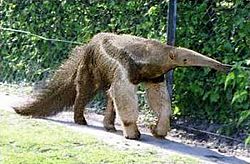 |
|
| Conservation status | |
| Scientific classification | |
| Kingdom: | |
| Class: | |
| Superorder: | |
| Order: | |
| Family: | |
| Genus: |
Myrmecophaga
|
| Binomial name | |
| Myrmecophaga tridactyla Linnaeus, 1758
|
|
The Giant Anteater (scientific name: Myrmecophaga tridactyla) is a unique animal found in Central and South America. It's sometimes called an ant bear. This amazing creature is the only mammal that doesn't have teeth. As its name suggests, it loves to eat ants and termites.
The Giant Anteater is the biggest of all anteaters. It can grow to be between 182 and 217 centimeters (about 6 to 7 feet) long. Males usually weigh between 33 and 41 kilograms (73-90 pounds), while females weigh 27 to 39 kilograms (60-86 pounds). Unlike other anteaters and sloths that live in trees, the Giant Anteater mostly stays on the ground. It looks for food in open areas and rests in forested habitats. It uses its strong front claws to dig up insect nests and its long, sticky tongue to collect its meal.
Contents
About the Giant Anteater's Body
You can easily spot a Giant Anteater by its large size, long snout, and big, bushy tail. Its head alone is about 30 centimeters (12 inches) long. Most of its head is taken up by its tube-shaped snout, which has a tiny mouth and nostrils at the end. Its eyes and ears are quite small. Giant Anteaters don't see very well, but their sense of smell is super strong—about 40 times better than a human's! In zoos, these animals can live for around 16 years.
The Giant Anteater has a thick neck and a small hump on its back. Its fur is mostly grey with white speckles. Its front legs are white with black bands near the wrists, and its back legs are dark. It has thick black stripes with white outlines that go from its throat to its shoulders. The rest of its body ends in a brown tail. The fur on its tail is very long, making the tail look even bigger. A stiff mane of hair runs along its back. Scientists used to think its bold pattern helped it blend in, but a recent study suggests it might be a warning sign to other animals. It's hard to tell males and females apart just by looking, even though males are a bit bigger and more muscular.
The Giant Anteater has wide ribs. Even though its scientific name means "three fingers," it actually has five toes on each foot. Its front feet have four toes with very long claws, especially on the second and third toes. It walks on its front knuckles, much like gorillas and chimpanzees. This way, its long claws stay out of the way when it walks. Its back feet have short claws on all five toes and walk flat on the ground. The anteater is a powerful digger, using its strong front limbs to pull and flex its claws.
Giant Anteaters have a lower body temperature than most mammals, around 33°C (91°F). This is a few degrees cooler than the usual 36–38°C (97-100°F) for mammals. Animals in the Xenarthra group (which includes anteaters, sloths, and armadillos) often have slower metabolic rates. This is thought to be because of their special diets and how they move.
How the Anteater Eats
The Giant Anteater has no teeth and can barely move its jaw. It opens and closes its mouth by rotating the two halves of its lower jaw, which are held together by a ligament. This creates a small opening for its long, thin tongue to flick out. The tongue is typically 60 centimeters (24 inches) long. It's covered in tiny, backward-curving bumps and coated in thick, sticky saliva. This sticky saliva helps the anteater pick up insects.
Because of its tube-like snout and small mouth, the tongue can only move in and out. When eating, the tongue moves very fast—about 160 times per minute, or almost three times per second! When fully stretched out, the tongue can reach 45 centimeters (18 inches), which is longer than its skull. Special muscles help the tongue slide back in without losing food and keep the mouth tight. When pulled back, the tongue rests in the throat, so it doesn't block breathing. The tongue is directly attached to the sternum (breastbone).
Giant Anteaters swallow much faster than most other mammals. They swallow almost constantly while eating. Before swallowing, insects are crushed against the roof of the mouth. The anteater's stomach works like a bird's gizzard. It has tough folds and strong muscles to grind up the insects. Small amounts of sand and soil that the anteater swallows also help with digestion. Giant Anteaters can't make their own stomach acid, so they use the formic acid from their prey to help digest their food.
Where Giant Anteaters Live and Their Status
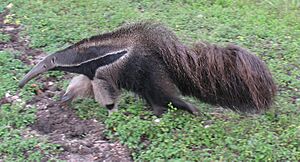
The Giant Anteater lives in Central and South America. Its home range goes from Honduras all the way to northern Argentina. Fossils have even been found as far north as Mexico. It's mostly absent from the Andes mountains and has disappeared from Uruguay. It might also be gone from Belize, Costa Rica, and Guatemala. These animals can live in many different places, from tropical rainforests to dry shrublands, as long as there's enough food for them.
The IUCN (International Union for Conservation of Nature) lists the Giant Anteater as "Vulnerable." This means its population is decreasing, partly because it has disappeared from some areas. It's also listed under Appendix II by CITES, which means trade in these animals is strictly controlled. Between 2000 and 2010, the total number of Giant Anteaters dropped by 30%. In 1994, about 340 Giant Anteaters died in wildfires at Emas National Park in Brazil. These animals are especially at risk from fires because they move slowly and their fur can catch fire easily.
Humans also pose threats to Giant Anteaters. They can be hit by cars, attacked by dogs, and lose their homes due to habitat destruction. In Bolivia, people sometimes hunt Giant Anteaters for sport or food. Their thick, tough hide is used to make equipment for horse riding in the Gran Chaco region. In Venezuela, they are hunted for their claws. Sometimes, anteaters are killed because people think they are dangerous. Despite these threats, Giant Anteaters are still found in many places. Some populations are stable, and they live in protected areas in the Amazon and the Cerrado. In some parts of Argentina, they are officially protected as a national heritage species.
Giant Anteater Behavior and Life
Giant Anteaters can use different types of habitats. A study in Brazil found that they usually look for food in open areas and rest in forests. This might be because forests are warmer on cold days and cooler on hot days. Giant Anteaters can be active during the day (diurnal) or at night (nocturnal). A study in the Pantanal found that they were mostly nocturnal, being most active at night and early morning. They would rest when the temperature rose. On colder days, they might start and end their activities earlier, moving into daylight hours. Anteaters active during the day have been seen in Serra da Canastra. Being nocturnal might be a way for them to avoid humans.
Giant Anteaters usually rest in thick bushes, but they might use tall grass on cooler days. They dig a shallow hole in the ground to rest in. When they sleep, they curl up with their bushy tail folded over their body. The tail helps them stay warm and also acts as camouflage. One anteater was seen sleeping with its tail stretched out on a sunny morning, possibly to soak up the sun's warmth.
Giant Anteaters are good swimmers and can cross wide rivers. They have even been seen bathing. They can also climb and have been recorded going up termite mounds and trees while looking for food. One anteater was seen holding onto a branch with its feet barely touching the ground.
Home Ranges and Communication
The size of a Giant Anteater's home ranges depends on where it lives. In a national park in Brazil, female anteaters had home ranges of about 3.67 square kilometers (907 acres), while males had ranges of 2.74 square kilometers (677 acres). In other parts of Brazil, their ranges can be as large as 9 square kilometers (2,224 acres). Anteaters in Venezuela have been known to have home ranges as big as 25 square kilometers (6,178 acres). These animals mostly live alone, except for mothers with their young and males looking for mates. Anteaters communicate using scents from their anal glands. They also mark trees and use urine to let others know they are around. They seem to be able to recognize each other's saliva by smell.
Females seem to be more accepting of other females than males are of other males. This means female home ranges often overlap more. Males are more likely to get into fights, like circling each other slowly, chasing, or actually fighting. When circling, they might make a long "harrr" sound. In a fight, they slash at each other with their claws and wrestle each other to the ground. Fighting anteaters might also roar or bellow. Males might be territorial.
Hunting for Food and Avoiding Predators
This animal is an insectivore, meaning it mainly eats ants and termites. In areas that flood seasonally, like the grassy plains of Venezuela, anteaters mostly eat ants because termites are harder to find. On the other hand, anteaters in Emas National Park mainly eat termites, which are very common there. In Serra da Canastra, anteaters switch between eating mostly ants during the wet season (October to March) and termites during the dry season (May to September).
Anteaters find their prey by smell. Once they find a nest, they tear it open with their strong front claws. Then, they stick in their long, sticky tongue to collect the insects. An anteater spends about one minute eating at each nest. It can visit up to 200 nests in one day and eat as many as 30,000 insects! Soldier ants or termites might try to bite or spray chemicals to drive the anteater away. Some termite species have very strong mounds for protection, and many individuals escape while the anteater is digging. These defenses help prevent the whole colony from being eaten in one attack.
Other foods include beetle larvae and honey bees that have built hives in termite mounds. Anteaters might even target termite mounds that have bee hives. In zoos, anteaters are fed special mixtures made of milk, eggs, mealworms, and ground beef. To drink, an anteater might dig for water if there's no surface water available. These waterholes can then be used by other animals too. Giant Anteaters are mainly hunted by jaguars and pumas. They usually run away from danger by galloping. But if they are cornered, they will stand on their hind legs and slash at the attacker. The Giant Anteater's front claws are very powerful weapons and can even kill a jaguar.
Although they are shy and usually try to avoid humans, Giant Anteaters can cause serious injuries with their front claws. They have been known to hurt or even kill humans who corner and threaten them. Between 2010 and 2012, two hunters in Brazil were killed by Giant Anteaters. In both cases, the hunters were bothering and hurting the animals, and the attacks seemed to be defensive actions.
Reproduction and Parenting
Giant Anteaters can mate all year round. Pregnancy lasts about 190 days, and usually only one baby (called a pup) is born. The pup typically weighs around 1.4 kilograms (3 pounds). Female anteaters give birth while standing up.
Pups are born with their eyes closed and open them after about six days. The mother carries her baby on her back. The pup's black and white stripe lines up with its mother's, which helps to camouflage it. The young communicate with their mothers by making sharp whistling sounds and use their tongues when nursing. After three months, the pup starts to eat solid food. It is fully weaned (stops drinking milk) by ten months. The mother grooms her baby during rest periods, sometimes for up to an hour. Grooming is most common during the first three months and decreases as the young anteater gets older, stopping by ten months. This decline shows that the bond between mother and baby is weakening. Young anteaters usually become independent around nine or ten months old. Anteaters are ready to have their own babies when they are 2.5 to 4 years old.
Giant Anteaters in Culture

In the stories and traditions of the native people in the Amazon Basin, the Giant Anteater is often shown as a clever trickster who outsmarts the jaguar. It's also seen as a funny character because of its long snout. In one tale, an anteater challenged a jaguar to a breath-holding contest underwater. After they took off their pelts and went underwater, the anteater jumped out and stole the jaguar's pelt, leaving the jaguar with the anteater's pelt. In another myth, an evil ogre is turned into an anteater by the sun. This story highlights how the anteater's mouth barely moves, which was seen as a burden. The Kayapo people wear masks of different animals and spirits, including the anteater, during naming and initiation ceremonies. They believed that women who touched anteater masks or men who stumbled while wearing them would die or get some kind of physical problem.
During the time when Spain was exploring and settling the Americas, the Giant Anteater was one of many native animals brought to Europe for people to see. At first, Europeans mistakenly thought all anteaters were female and mated with their noses! A naturalist named Félix de Azara later corrected this idea. In the 20th century, the artist Salvador Dalí wrote in his imagination that the Giant Anteater "reaches sizes bigger than the horse, possesses enormous ferocity, has exceptional muscle power, is a terrifying animal."
The 1940 Max Fleischer cartoon Ants in the Plants shows a colony of ants fighting off a mean anteater. This film, released during a time of war, might have been a reference to France's Maginot Line.
An anteater is also a character in the comic strip B.C.. This character inspired Peter the Anteater, the mascot for the University of California, Irvine team.
The Flash cartoon Happy Tree Friends features an anteater named Sniffles.
In the Stephen King miniseries Kingdom Hospital, a character named Antubis appears as an anteater-like creature with very sharp teeth.
Images for kids
See also
 In Spanish: Oso hormiguero gigante para niños
In Spanish: Oso hormiguero gigante para niños




